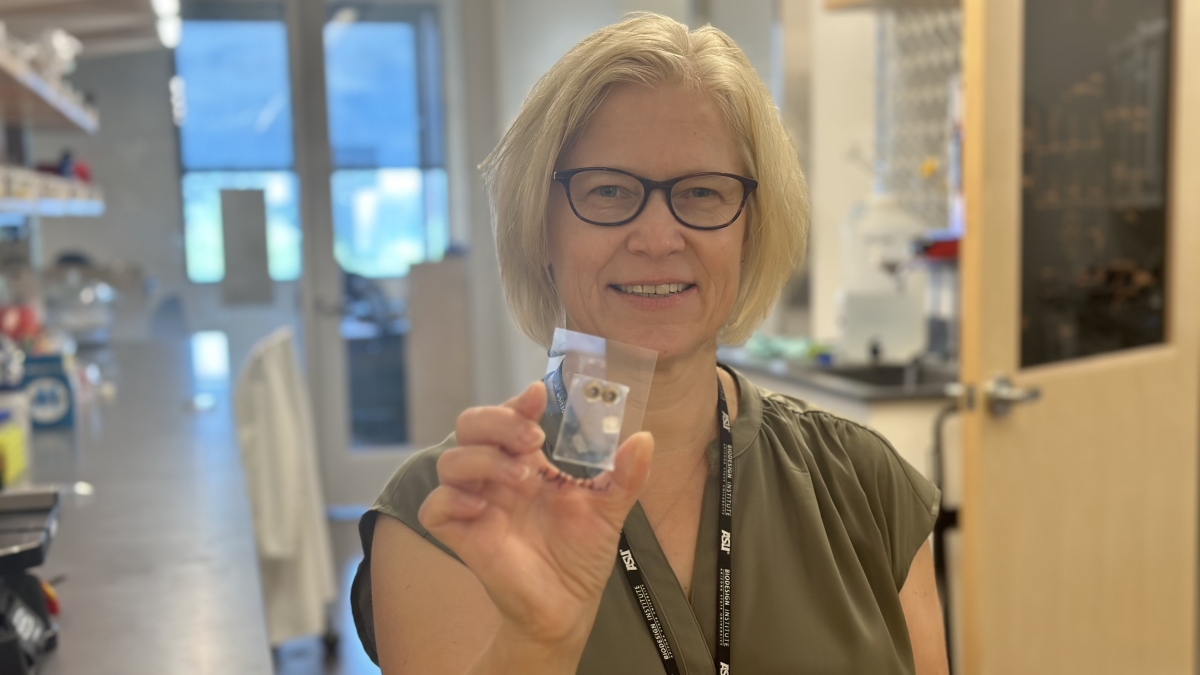Intercontinental team to grow protein crystals in space

ASU Professor Alexandra Ros holds a prototype of a microfluidic protein crystallization device. Photo courtesy the School of Molecular Sciences
An interdisciplinary team including Alexandra Ros, professor in Arizona State University’s School of Molecular Sciences and faculty member in the Biodesign Institute’s Center for Applied Structural Discovery, is taking one giant leap into a new sector of the global aerospace industry.
The team has received $9.87 million from the Ministry of Business, Innovation and Employment Endeavour Fund to develop research platforms in microgravity, specifically related to protein crystallization.
The principal investigator on the award is Sarah Kessans, a senior lecturer from Te Whare Wānanga o Waitaha - University of Canterbury (UC) School of Product Design, New Zealand. Kessans received her PhD in 2011 from ASU’s School of Life Sciences and was advised by Professor Tsafrir Mor, also of the Biodesign Institute.
The team will grow microcrystals in microgravity, which are often higher quality than crystals grown on Earth, and can be used to generate higher-resolution protein structures. This allows researchers in the pharmaceutical and biotechnology industries to acquire previously inaccessible data for use in a wide range of biomedical and life sciences applications.
“My role in the project is to develop microfluidic protein crystallization devices for space travel and space operation,” Ros said. “The devices will have integrated capabilities to initiate crystallization in space and require minimal astronaut time on manned space stations.”
Key members of the research team also include Volker Nock, associate professor from UC’s faculty of engineering, and Cather Simpson and Freddy Lyzwa from the University of Auckland. Industry collaborators include David Wright of Asteria Engineering Consulting and Dave Sanders and Aleksandar Lazic of Intranel Consulting.
Ros’ current research interests include migration mechanisms in the micro- and nano-environment for biomolecules and subcellular species, with a focus on electrokinetic methods, hyphenation of analytical approaches for single-cell analysis, and development of microfluidic tools for emerging crystallography techniques.
“Alexandra’s work is typified by outstanding scholarship and a relentless commitment to making critical advances that benefit science and society at large,” said Tijana Rajh, director of the School of Molecular Sciences. “I am very happy to see her recognized with this outstanding and richly deserved grant.”
The Endeavour funding will enable the research team to build their previously developed protein crystallization prototype toward fully automated crystallization facilities ready for future commercial space station research. The funding will allow the team to design, fabricate and test specialized hardware and software subsystems and then validate the complete designs in microgravity through their partnership with the United States-based company Axiom Space.
“The research and the future commercial outputs from the program sit at the interface between aerospace and biotechnology, two increasingly valuable sectors of the world economy,” Kessans said. “We have the opportunity to expand the offerings of both while developing globally leading research capabilities.”
Axiom Space is a leading provider of human spaceflight services and developer of human-rated space infrastructure, including the world’s first commercial space station in low Earth orbit: Axiom Station. The partnership with Axiom Space will allow researchers to make regular, frequent and cost-effective missions to the International Space Station (ISS), and following the ISS’s scheduled retirement, to Axiom Station, due to launch its first module to the ISS in 2026.
Related to protein crystallography, Ros has also developed a unique method for reducing sample size and waste (which can be as high as 99%) in her team’s serial femtosecond crystallography with X-ray free electron laser (XFEL) experiments.
The method is specifically appealing for hard-to-crystallize proteins, such as membrane proteins, as it yields high-resolution structural information from small micro- or nanocrystals, thus reducing the contribution of crystal defects and avoiding tedious (if not impossible) growth of large crystals, as is required in traditional synchrotron-based crystallography. Ros is also part of the team developing the first compact X-ray free electron laser (CXFEL) at ASU, where related approaches to sample delivery and crystallization are explored.
More Science and technology

The Sun Devil who revolutionized kitty litter
If you have a cat, there’s a good chance you’re benefiting from the work of an Arizona State University alumna. In honor of Women's History Month, we're sharing her story.A pioneering chemist…

ASU to host 2 new 51 Pegasi b Fellows, cementing leadership in exoplanet research
Arizona State University continues its rapid rise in planetary astronomy, welcoming two new 51 Pegasi b Fellows to its exoplanet research team in fall 2025. The Heising-Simons Foundation awarded the…

ASU students win big at homeland security design challenge
By Cynthia GerberArizona State University students took home five prizes — including two first-place victories — from this year’s Designing Actionable Solutions for a Secure Homeland student design…

